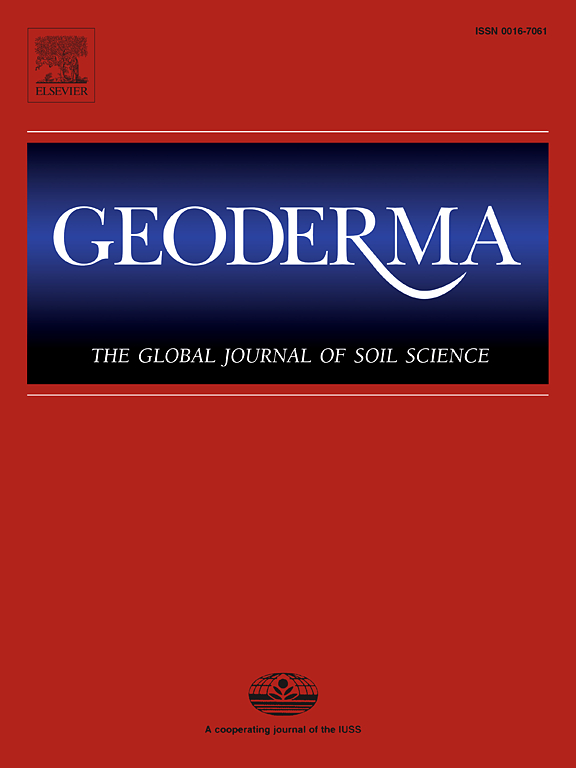不同小麦品种根系性状对土壤结构的影响:x射线计算机断层扫描和根系形态研究
IF 6.6
1区 农林科学
Q1 SOIL SCIENCE
引用次数: 0
摘要
植物根系在保持土壤健康方面起着重要作用。虽然已经报道了大量的根系性状,但很少有研究试图将根系形态与土壤结构联系起来。在这里,我们使用铲组学来表征小麦品种(Paragon)和两个地方品种(Senatore-Cappelli和Watkins238)的根系形态,并使用先进的土壤孔隙和根系网络x射线计算机断层扫描来评估它们在圆柱体和团粒尺度上对土壤形态的影响。裸地作为对照进行分析。计算了闵可夫斯基泛函和渗流理论参数来表征土壤孔隙网络形态。与裸地相比,各品种在柱体尺度上的生物孔隙度差异显著。裸露土壤结构孔体积最大,生物孔体积最小,表明生物孔的降解速度较快。在圆柱体尺度上,Senatore-Cappelli和Watkins238的生物孔特征有显著差异,Senatore-Cappelli表现出更多直径为1mm的孔。从渗流理论得到的参数表明,根际土壤样品与裸土样品之间存在显著差异。我们发现基因型之间存在显著差异,根系形态参数和孔网络几何形状之间存在统计学上显著的相关性。总成像孔隙度和总根体积是根对土壤结构影响的有限描述因子,孔隙网络连通性测量可以更好地量化根对土壤结构的影响。我们的研究结果证实了之前关于根系性状与土壤性状之间关系的研究,并强调了我们的实验方法在探索不同基因型如何影响土壤形态方面的潜力,为未来在植物表型分析中的应用铺平了道路。本文章由计算机程序翻译,如有差异,请以英文原文为准。
Root traits of different wheat cultivars influence soil structure: an X-ray computed tomography and root morphology study
Plant roots play a fundamental role in maintaining soil health. Although a broad range of root traits have been reported, few studies have attempted to link root morphology with soil structure. Here, we used shovelomics to characterize the root morphology of a wheat cultivar (Paragon), and two landraces (Senatore-Cappelli, and Watkins238), and advanced soil pore and root network X-ray computed tomography to assess their impact on soil morphology at cylinder and aggregate scales. Bare soil was analyzed as a control. Minkowski functionals and percolation theory parameters were computed to characterize soil pore network morphology. Bioporosity at the cylinder scale was significantly different for all cultivars compared to the bare soil. Bare soil presented the largest structural pore volume and the smallest biopore volume, this suggesting rapid degradation of biopores. At the cylinder scale, biopore characteristics were significantly different between Senatore-Cappelli and Watkins238, with Senatore-Cappelli exhibiting more pores with diameters >1 mm. The parameters from percolation theory revealed notable differences between the rhizospheric and bare soil samples. We found significant differences between genotypes, finding statistically significant correlations among root morphology parameters and pore network geometry.
Total imaged porosity and total root volume were limited descriptors of the effect of roots on soil structure, which is better quantified by pore network connectivity measurements. Our findings confirm previous studies on the relationship between root traits and soil properties and highlight the potential of our experimental approach to explore how different genotypes may influence soil morphology, paving the way for future applications in plant phenotyping.
求助全文
通过发布文献求助,成功后即可免费获取论文全文。
去求助
来源期刊

Geoderma
农林科学-土壤科学
CiteScore
11.80
自引率
6.60%
发文量
597
审稿时长
58 days
期刊介绍:
Geoderma - the global journal of soil science - welcomes authors, readers and soil research from all parts of the world, encourages worldwide soil studies, and embraces all aspects of soil science and its associated pedagogy. The journal particularly welcomes interdisciplinary work focusing on dynamic soil processes and functions across space and time.
 求助内容:
求助内容: 应助结果提醒方式:
应助结果提醒方式:


